Learning area: Technology
Time commitment: Moderate (30 minutes to 1 hour), plus 3 hours of dry time
Best for: Grade 3, Grade 4, Grade 5, Grade 6

Use binary code to make a beautiful piece of art that displays your name or a secret message.
![]()
Materials:
- white canvas
- Elmer’s Extra Strength Glue Stick
- pom-poms in 3 colors
- binary code key (we recommend using this one)
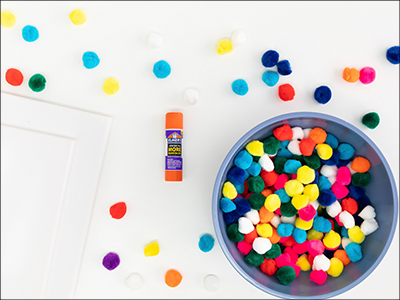
![]()
Instructions:
- Choose what you want to say in code. You can write your name or a fun saying, like Kind Is Cool! or Go Team! Write your words on a piece of paper and then use the binary code key to translate each letter into code. For example, the code below spells out “Jaylah”:
J = 0100 1010
A = 0100 0001
Y = 0101 1001
L = 0100 1100
A = 0100 0001
H = 0100 1000
- Now choose one color to represent your 1’s in the code and a different color to represent your 0’s in the code. The third color will be your background.
- Arrange your pom-poms in rows to spell the name or word you are coding. For example, if you are coding the letter J and you chose dark blue for 1 and light blue for 0, your pattern would be Light – Dark – Light – Light – Dark – Light – Dark – Light.
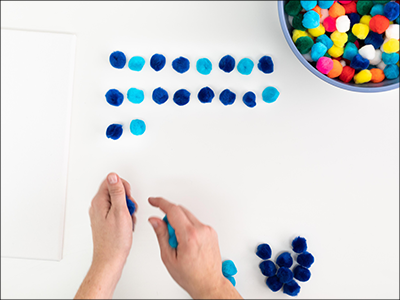
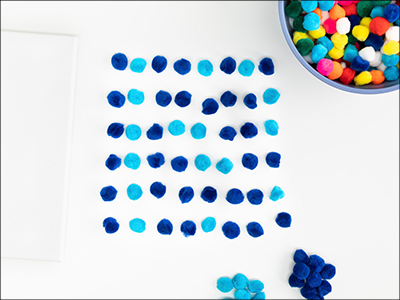

- Use Elmer’s Extra Strength Glue Stick to create a line of glue on the canvas. Stick your pom-poms to the canvas in order. Go slowly to make sure you don’t mix up the order. (Now you can see why code-crackers are known for being mathematical geniuses!)
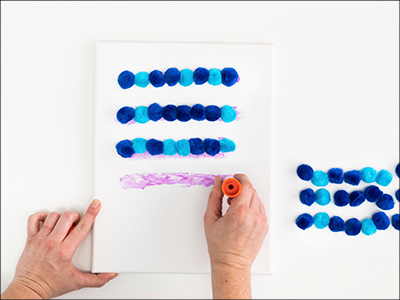

- Once you’ve written your name, word, or saying, you can fill in the background with the third color.
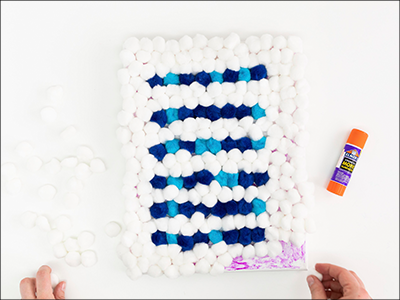

- Once the glue dries (which should be really fast!), you can display your art for all to see.
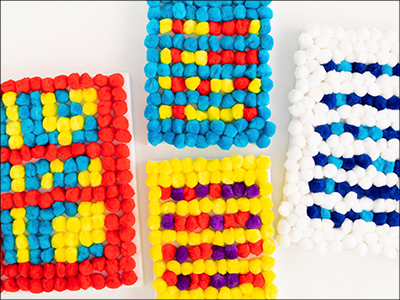
Learn More: What in the world is binary code?
The question actually should be What in the universe is binary code? because the primary uses of binary code are sometimes out of this world—literally. Binary code is a two-symbol coding system (which is why we used two colors to represent the two symbols) that is used by NASA to gather information from space stations and observatories. It’s also used by many computer systems to collect, store, and record data.
Not all coding requires a computer! Activities that you can do without a device that get you coding and thinking about computing are called unplugged activities. What you just did is considered an unplugged coding activity—you actually learned about how computers operate without touching a computer.
Level Up: Options for Older Kids
- Want to try more? Try using your pom-pom balls to write an entire sentence or poem in code art. Then, give your parents or a friend your code art and see whether they can figure out what you are saying.
- Write your own coding language. Systems like binary code are often called coding languages. These languages are used by computer programmers to write programs, software, and more. Challenge yourself to write your own coding language. Make a coding key, like the binary code key we gave you above, by assigning your own symbols or patterns to represent each letter of the alphabet. Then write a letter to a friend or family member using your new code. Give them the key to see whether they can read your message.
- Your bedroom décor just got an upgrade. Pom-pom code art is really beautiful—it’s colorful and follows a geometric pattern that is very pleasing to the eye. It looks great, doesn’t it? Make several pieces of code art and hang them in your room. Not only will it look great; you’ll also be sending secret messages that only the most astute code-breakers will be able to decipher.
![]()
Standards Alignment: CSTA K-12 CS Standards
2-DA-07: Represent data using multiple encoding schemes – Data representations occur at multiple levels of abstraction, from the physical storage of bits to the arrangement of information into organized formats (e.g., tables). Students should represent the same data in multiple ways. For example, students could represent the same color using binary, RGB values, hex codes (low-level representations), as well as forms understandable by people, including words, symbols, and digital displays of the color (high-level representations).
Practice(s): Developing and Using Abstractions: 4



